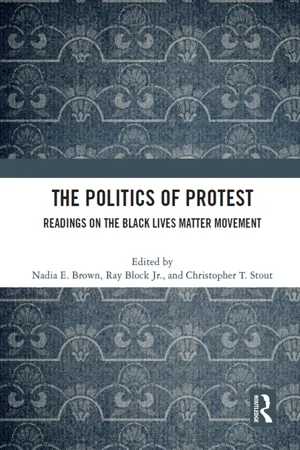Introduction
During August 2014, striking images of unrest and clashes between police and protesters were transmitted from Ferguson, Missouri onto front pages, television screens, and social media feeds across the nation. These images transformed “Black Lives Matter,” (BLM) originally a movement organized by three Black women in the aftermath of the George Zimmerman acquittal in the Trayvon Martin trial, to a national rally cry – and lightning rod for controversy. In the three years since protests erupted in response to the killing of unarmed Black teen Michael Brown by police officer Darren Wilson, the issue of police treatment of racial minorities (particularly, although not limited to African Americans) has been propelled to the national stage of political discourse.
Ferguson was far from the first time police violence against vulnerable communities surfaced in the national agenda. Police brutality received prominent attention after the 1919 passage of the Volstead Act, culminating in the Wickersham Commission's claim that “the use of physical brutality, or other forms of cruelty, to obtain involuntary confessions or admissions – is widespread” amongst police officers. In the 1940s, police targeted Mexican-Americans with physical violence in the Zoot Suit Riots. During the height of the Civil Rights Movement, Black Civil Rights leaders were targeted by J. Edgar Hoover's FBI through COINTELPRO, which included wiretapping conversations, intimidation, infiltrating organizations, and even assassinations of leaders within the Black Panther Party. In the early 1990s, police brutality against Blacks returned to salience after the acquittal of the officers in the Rodney King beating trial. The events in Ferguson, MO in 2014 were another instance in the long-running contested political discourse over policing and violence.
Technological advances and the rise of social media may have provided activists and advocates in Ferguson with a new platform to press for legal and political action to increase accountability mechanisms for police officers. But also prominent during this era are efforts to frame the movement for Black lives as either divisive or threatening to the well-being of police officers. The rise of counter-frames such as “All Lives Matter” and “Blue Lives Matter” exemplify challenges faced by advocates for racial minorities, as they face uphill struggles both to get their issues considered on the mainstream political agenda and then to “own” the framing of those issues once they are finally considered.
We endeavor to ask which frames traditional mainstream media outlets employed in reporting on the movement for police accountability in the post-Ferguson era. Do news reports on BLM and related advocacy movements paint such efforts as legitimate and justified, or menacing and ineffectual? Correspondingly, do reports on police units and officers paint these actors as above reproach, or worthy of critical scrutiny?
We expect that the dominant frames employed in news depictions of the major players in the debate over policing have clear implications for the volume and content of policy actions taken on the issue. Since the Ferguson unrest catapulted this issue once again to the forefront of the political agenda, lawmakers across the nation have sought to stake out their positions. To which competing sub-constituencies these lawmakers seek to provide responsiveness should be a function, in part, of their perceptions of the relative legitimacy of the groups’ respective claims.
We argue these perceptions are meaningfully shaped by the lenses offered by media reporting on police and protesters. If the motives or methods of advocates for police accountability are constantly called into question in news media accounts, legislators face less incentive to respond to their demands. Alternately, if news reporting casts police units as prone to racial bias or abuse of power, then legislators may feel pressure to signal their efforts to enact tighter control over the police in their jurisdiction.
Using two original datasets, we provide preliminary tests of the claim that the volume and framing of media coverage around policing and policing-related protests have an effect on the legislative output on policing. We trace the correlation between the amount and framing of coverage of policing controversies by prominent newspaper outlets pre- and post-Ferguson and the amount and type of policing-related bills proposed and passed by all 50 state legislatures during the same period. From such trends can be drawn key inferences about the political significance of the news media's agenda setting and agenda building functions in a racially polarizing issue area.
Our trends suggest that both amount and framing of media coverage on policing have an association with the volume of state legislative activity on policing. News frames depicting protesters favorably are met with state bills that increase accountability mechanisms on police. Conversely, news stories depicting positive portrayals of police are met with state bills enhancing autonomy of police. Finally, once news attention to policing subsides, so too does the amount of state legislative activity on policing. We present here the opening stage of a project aimed at making nuanced inferences about the role of news media as a political actor, either brightening or dimming the prospects for marginalized communities seeking to assert their issues onto the national agenda.
Media as agenda setter and agenda builder
The Civil Rights-era removal of formal barriers to electoral participation heralded forceful calls for African Americans to shift their collective political strategy from protest to electoral politics (Browning, Marshall, and Tabb 1984; Tate 1994). But despite the absence of legal barriers, informal obstacles remain to Black Americans receiving adequate political responsiveness to their demands.
Such obstacles include lessened efforts by partisan elites to mobilize Black Americans, dampening Black participation (Rosenstone and Hansen 1993). Additionally, Blacks are underrepresented among the economic elite class, to which policymakers are most responsive (Gilens and Page 2014). Furthermore, as evidenced by experimental work by Butler and Broockman (2011), constituents perceived to be Black receive less consideration from state legislators than those perceived to be White.
In light of these barriers to responsiveness through conventional political channels, African Americans and other racial minorities often issue calls for greater police accountability through m...
